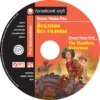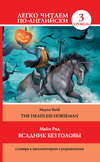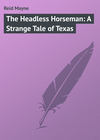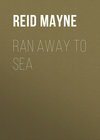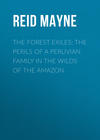Read the book: «Odd People: Being a Popular Description of Singular Races of Man», page 4
Chapter Three.
The Water-Dwellers of Maracaibo
The Andes mountains, rising in the extreme southern point of South America, not only extend throughout the whole length of that continent, but continue on through Central America and Mexico, under the name of “Cordilleras de Sierra Madre;” and still farther north to the shores of the Arctic Sea, under the very inappropriate appellation of the “Rocky Mountains.” You must not suppose that these stupendous mountains form one continuous elevation. At many places they furcate into various branches, throwing off spurs, and sometime parallel “sierras,” between which lie wide “valles,” or level plains of great extent. It is upon these high plateaux – many of them elevated 7,000 feet above the sea – that the greater part of the Spanish-American population dwells; and on them too are found most of the large cities of Spanish South America and Mexico.
These parallel chains meet at different points, forming what the Peruvians term “nodas” (knots); and, after continuing for a distance in one great cordillera, again bifurcate. One of the most remarkable of these bifurcations of the Andes occurs about latitude 2 degrees North. There the gigantic sierra separates into two great branches, forming a shape like the letter Y, the left limb being that which is usually regarded as the main continuation of these mountains through the Isthmus of Panama, while the right forms the eastern boundary of the great valley of the Magdalena river; and then, trending in an eastwardly direction along the whole northern coast of South America to the extreme point of the promontory of Paria.
Each of these limbs again forks into several branches or spurs, – the whole system forming a figure that may be said to bear some resemblance to a genealogical tree containing the pedigree of four or five generations.
It is only with one of the bifurcations of the right or eastern sierra that this sketch has to do. On reaching the latitude of 7 degrees north, this chain separates itself into two wings, which, after diverging widely to the east and west, sweep round again towards each other, as if desirous to be once more united. The western wing advances boldly to this reunion; but the eastern, after vacillating for a time, as if uncertain what course to take, turns its back abruptly on its old comrade, and trends off in a due east direction, till it sinks into insignificance upon the promontory of Paria.
The whole mass of the sierra, however, has not been of one mind; for, at the time of its indecision, a large spur detaches itself from the main body, and sweeps round, as if to carry out the union with the left wing advancing from the west. Although they get within sight of each other, they are not permitted to meet, – both ending abruptly before the circle is completed, and forming a figure bearing a very exact resemblance to the shoe of a racehorse. Within this curving boundary is enclosed a vast valley, – as large as the whole of Ireland, – the central portion of which, and occupying about one third of its whole extent, is a sheet of water, known from the days of the discovery of America, as the Lake of Maracaibo.
It obtained this appellation from the name of an Indian cazique, who was met upon its shores by the first discoverers; but although this lake was known to the earliest explorers of the New World, – although it lies contiguous to many colonial settlements both on the mainland and the islands of the Caribbean Sea, – the lake itself and the vast territory that surrounds it, remain almost as unknown and obscure as if they were situated among the central deserts of Africa.
And yet the valley of Maracaibo is one of the most interesting portions of the globe, – interesting not only as a terra incognita, but on account of the diversified nature of its scenery and productions. It possesses a fauna of a peculiar kind, and its flora is one of the richest in the world, not surpassed, – perhaps not equalled, – by that of any other portion of the torrid zone. To give a list of its vegetable productions would be to enumerate almost every species belonging to tropical America. Here are found the well-known medicinal plants, – the sassafras and sarsaparilla, guaiacum, copaiva, cinchona, and cuspa, or Cortex Angosturae; here are the deadly poisons of barbasco and mavacure, and alongside them the remedies of the “palo sano,” and mikania guaco. Here likewise grow plants and trees producing those well-known dyes of commerce, the blue indigo, the red arnotto, the lake-coloured chica, the brazilletto, and dragon’s-blood; and above all, those woods of red, gold, and ebon tints, so precious in the eyes of the cabinet and musical-instrument makers of Europe.
Yet, strange to say, these rich resources lie, like treasures buried in the bowels of the earth, or gems at the bottom of the sea, still undeveloped. A few small lumbering establishments near the entrance of the lake, – here and there a miserable village, supported by a little coast commerce in dyewoods, or cuttings of ebony, – now and then a hamlet of fishermen, – a “hato” of goats and sheep; and at wider intervals, a “ganaderia” of cattle, or a plantation of cocoa-trees (cocale), furnish the only evidence that man has asserted his dominion over this interesting region. These settlements, however, are sparsely distributed, and widely distant from one another. Between them stretch broad savannas and forests, – vast tracts, untitled and even unexplored, – a very wilderness, but a wilderness rich in natural resources.
The Lake of Maracaibo is often, though erroneously, described as an arm of the sea. This description only applies to the Gulf of Maracaibo, which is in reality a portion of the Caribbean Sea. The lake itself is altogether different, and is a true fresh-water lake, separated from the gulf by a narrow neck or strait. Within this strait – called “boca,” or mouth – the salt water does not extend, except during very high tides or after long-continued nortes (north winds), which have the effect of driving the sea-water up into the lake, and imparting to some portions of it a saline or brackish taste. This, however, is only occasional and of temporary continuance; and the waters of the lake, supplied by a hundred streams from the horseshoe sierra that surrounds it, soon return to their normal character of freshness.
The shape of Lake Maracaibo is worthy of remark. The main body of its surface is of oval outline, – the longer diameter running north and south, – but taken in connection with the straits which communicate with the outer gulf, it assumes a shape somewhat like that of a Jew’s-harp, or rather of a kind of guitar, most in use among Spanish Americans, and known under the name of “mandolin” (or “bandolon”). To this instrument do the natives sometimes compare it.
Another peculiarity of Lake Maracaibo, is the extreme shallowness of the water along its shores. It is deep enough towards the middle part; but at many points around the shore, a man may wade for miles into the water, without getting beyond his depth. This peculiarity arises from the formation of the valley in which it is situated. Only a few spurs of the sierras that surround it approach near the edge of the lake. Generally from the bases of the mountains, the land slopes with a very gentle declination, – so slight as to have the appearance of a perfectly horizontal plain, – and this is continued for a great way under the surface of the water. Strange enough, however, after getting to a certain distance from the shore, the shoal water ends as abruptly as the escarpment of a cliff, and a depth almost unfathomable succeeds, – as if the central part of the lake was a vast subaqueous ravine, bounded on both sides by precipitous cliffs. Such, in reality, is it believed to be.
A singular phenomenon is observed in the Lake Maracaibo, which, since the days of Columbus, has not only puzzled the Curious, but also the learned and scientific, who have unsuccessfully attempted to explain it. This phenomenon consists in the appearance of a remarkable light, which shows itself in the middle of the night, and at a particular part of the lake, near its southern extremity. This light bears some resemblance to the ignis fatuus of our own marshes; and most probably is a phosphorescence of a similar nature, though on a much grander scale, – since it is visible at a vast distance across the open water. As it is seen universally in the same direction, and appears fixed in one place, it serves as a beacon for the fishermen and dye-wood traders who navigate the waters of the lake, – its longitude being precisely that of the straits leading outward to the gulf. Vessels that have strayed from their course, often regulate their reckoning by the mysterious “Farol de Maracaibo” (Lantern of Maracaibo), – for by this name is the natural beacon known to the mariners of the lake.
Various explanations have been offered to account for this singular phenomenon, but none seem to explain it in a satisfactory manner. It appears to be produced by the exhalations that arise from an extensive marshy tract lying around the mouth of the river Zulia, and above which it universally shows itself. The atmosphere in this quarter is usually hotter than elsewhere, and supposed to be highly charged with electricity; but whatever may be the chemical process which produces the illumination, it acts in a perfectly silent manner. No one has ever observed any explosion to proceed from it, or the slightest sound connected with its occurrence.
Of all the ideas suggested by the mention of Lake Maracaibo, perhaps none are so interesting as those that relate to its native inhabitants, whose peculiar habits and modes of life not only astonished the early navigators, but eventually gave its name to the lake itself and to the extensive province in which it is situated. When the Spanish discoverers, sailing around the shores of the gulf, arrived near the entrance of Lake Maracaibo, they saw, to their amazement, not only single houses, but whole villages, apparently floating upon the water! On approaching nearer, they perceived that these houses were raised some feet above the surface, and supported by posts or piles driven into the mud at the bottom. The idea of Venice – that city built upon the sea, to which they had been long accustomed – was suggested by these superaqueous habitations; and the name of Venezuela (Little Venice) was at once bestowed upon the coast, and afterwards applied to the whole province now known as the Republic of Venezuela.
Though the “water villages” then observed have long since disappeared, many others of a similar kind were afterwards discovered in Lake Maracaibo itself, some of which are in existence to the present day. Besides here and there an isolated habitation, situated in some bay or “laguna,” there are four principal villages upon this plan still in existence, each containing from fifty to a hundred habitations. The inhabitants of some of these villages have been “Christianised,” that is, have submitted to the teaching of the Spanish missionaries; and one in particular is distinguished by having its little church – a regular water church – in the centre, built upon piles, just as the rest of the houses are, and only differing from the common dwellings in being larger and of a somewhat more pretentious style. From the belfry of this curious ecclesiastical edifice a brazen bell may be heard at morn and eve tolling the “oracion” and “vespers,” and declaring over the wide waters of the lake that the authority of the Spanish monk has replaced the power of the cazique among the Indians of the Lake Maracaibo. Not to all sides of the lake, however, has the cross extended its conquest. Along its western shore roams the fierce unconquered Goajiro, who, a true warrior, still maintains his independence; and even encroaches upon the usurped possessions both of monk and “militario.”
The water-dweller, however, although of kindred race with the Goajiro, is very different, both in his disposition and habits of life. He is altogether a man of peace, and might almost be termed a civilised being, – that is, he follows a regular industrial calling, by which he subsists. This is the calling of a fisherman, and in no part of the world could he follow it with more certainty of success, since the waters which surround his dwelling literally swarm with fish.
Lake Maracaibo has been long noted as the resort of numerous and valuable species of the finny tribe, in the capture of which the Indian fisherman finds ample occupation. He is betimes a fowler, – as we shall presently see, – and he also sometimes indulges, though more rarely, in the chase, finding game in the thick forests or on the green savannas that surround the lake, or border the banks of the numerous “riachos” (streams) running into it. On the savanna roams the graceful roebuck and the “venado,” or South-American deer, while along the river banks stray the capibara and the stout tapir, undisturbed save by their fierce feline enemies, the puma and spotted jaguar.
But hunting excursions are not a habit of the water Indian, whose calling, as already observed, is essentially that of a fisherman and “fowler,” and whose subsistence is mainly derived from two kinds of water-dwellers, like himself – one with fins, living below the surface, and denominated fish; another with wings, usually resting on the surface, and known as fowl. These two creatures, of very different kinds and of many different species, form the staple and daily food of the Indian of Maracaibo.
In an account of his habits we stall begin by giving a description of the mode in which he constructs his singular dwelling.
Like other builders he begins by selecting the site. This must be a place where the water is of no great depth; and the farther from the shore he can find a shallow spot the better for his purpose, for he has a good reason for desiring to get to a distance from the shore, as we shall presently see. Sometimes a sort of subaqueous island, or elevated sandbank, is found, which gives him the very site he is in search of. Having pitched upon the spot, his next care is to procure a certain number of tree-trunks of the proper length and thickness to make “piles.” Not every kind of timber will serve for this purpose, for there are not many sorts that would long resist decay and the wear and tear of the water insects, with which the lake abounds. Moreover, the building of one of these aquatic houses, although it be only a rude hut, is a work of time and labour, and it is desirable therefore to make it as permanent as possible. For this reason great care is taken in the selection of the timber for the “piles.”
But it so chances that the forests around the lake furnish the very thing itself, in the wood of a tree known to the Spanish inhabitants as the “vera,” of “palo sano,” and to the natives as “guaiac.” It is one of the zygophyls of the genus Guaiacum, of which there are many species, called by the names of “iron-wood” or “lignum-vitae;” but the species in question is the tree lignum-vitae (Guaiacum arboreum), which attains to a height of 100 feet, with a fine umbrella-shaped head, and bright orange flowers. Its wood is so hard, that it will turn the edge of an axe, and the natives believe that if it be buried for a sufficient length of time under the earth it will turn to iron! Though this belief is not literally true, as regards the iron, it is not so much of an exaggeration as might be supposed. The “palo de fierro,” when buried in the soil of Maracaibo or immersed in the waters of the lake, in reality does undergo a somewhat similar metamorphose; in other words, it turns into stone; and the petrified trunks of this wood are frequently met with along the shores of the lake. What is still more singular – the piles of the water-houses often become petrified, so that the dwelling no longer rests upon wooden posts, but upon real columns of stone!
Knowing all this by experience, the Indian selects the guaiac for his uprights, cuts them of the proper length; and then, launching them in the water, transports them to the site of his dwelling, and fixes them in their places.
Upon this a platform is erected, out of split boards of some less ponderous timber, usually the “ceiba,” or “silk-cotton tree” (Bombax ceiba), or the “cedro negro” (Cedrela odorata) of the order Meliaceae. Both kinds grow in abundance upon the shores of the lake, – and the huge trunks of the former are also used by the water Indian for the constructing of his canoe.
The platform, or floor, being thus established, about two or three feet above the surface of the water, it then only remains to erect, the walls and cover them over with a roof. The former are made of the slightest materials, – light saplings or bamboo poles, – usually left open at the interstices. There is no winter or cold weather here, – why should the walls be thick? There are heavy rains, however, at certain seasons of the year, and these require to be guarded against; but this is not a difficult matter, since the broad leaves of the “enea” and “vihai” (a species of Heliconia) serve the purpose of a roof just as well as tiles, slates, or shingles. Nature in these parts is bountiful, and provides her human creatures with a spontaneous supply of every want. Even ropes and cords she furnishes, for binding the beams, joists, and rafters together, and holding on the thatch against the most furious assaults of the wind. The numerous species of creeping and twining plants (“llianas” or “sipos”) serve admirably for this purpose. They are applied in their green state, and when contracted by exsiccation draw the timbers as closely together as if held by spikes of iron. In this manner and of such materials does the water Indian build his house.
Why he inhabits such a singular dwelling is a question that requires to be answered. With the terra firma close at hand, and equally convenient for all purposes of his calling, why does he not build his hut there? So much easier too of access would it be, for he could then approach it either by land or by water; whereas, in its present situation, he can neither go away from his house or get back to it without the aid of his “periagua” (canoe). Moreover, by building on the beach, or by the edge of the woods, he would spare himself the labour of transporting those heavy piles and setting them in their places, – a work, as already stated, of no ordinary magnitude. Is it for personal security against human enemies, – for this sometimes drives a people to seek singular situations for their homes? No; the Indian of Maracaibo has his human foes, like all other people; but it is none of these that have forced him to adopt this strange custom. Other enemies? wild beasts? the dreaded jaguar, perhaps? No, nothing of this kind. And yet it is in reality a living creature that drives him to this resource, – that has forced him to flee from the mainland and take to the water for security against its attack, – a creature of such small dimensions, and apparently so contemptible in its strength, that you will no doubt smile at the idea of its putting a strong man to flight, – a little insect exactly the size of an English gnat, and no bigger, but so formidable by means of its poisonous bite, and its myriads of numbers, as to render many parts of the shores of Lake Maracaibo quite uninhabitable. You guess, no doubt, the insect to which I allude? You cannot fail to recognise it as the mosquito? Just so; it is the mosquito I mean, and in no part of South America do these insects abound in greater numbers, and nowhere are they more bloodthirsty than upon the borders of this great fresh-water sea. Not only one species of mosquito, but all the varieties known as “jejens,” “zancudos,” and “tempraneros,” here abound in countless multitudes, – each kind making its appearance at a particular hour of the day or night, – “mounting guard” (as the persecuted natives say of them) in turn, and allowing only short intervals of respite from their bitter attacks.
Now, it so happens, that although the various kinds of mosquitoes are peculiarly the productions of a marshy or watery region, – and rarely found where the soil is high and dry, – yet as rarely do they extend their excursions to a distance from the land. They delight to dwell under the shadow of leaves, or near the herbage of grass, plants, or trees, among which they were hatched. They do not stray far from the shore, and only when the breeze carries them do they fly out over the open water. Need I say more? You have now the explanation why the Indians of Maracaibo build their dwellings upon the water. It is simply to escape from the “plaga de moscas” (the pest of the flies).
Like most other Indians of tropical America, and some even of colder latitudes, those of Maracaibo go naked, wearing only the guayueo, or “waist-belt.” Those of them, however, who have submitted to the authority of the monks, have adopted a somewhat more modest garb, – consisting of a small apron of cotton or palm fibre, suspended from the waist, and reaching down to their knees.
We have already stated, that the water-dwelling Indian is a fisherman, and that the waters of the lake supply him with numerous kinds of fish of excellent quality. An account of these, with the method employed in capturing them, may not prove uninteresting.
First, there is the fish known as “liza,” a species of skate. It is of a brilliant silvery hue, with bluish corruscations. It is a small fish, being only about a foot in length, but is excellent to eat, and when preserved by drying, forms an article of commerce with the West-Indian islands. Along the coasts of Cumana and Magarita, there are many people employed in the pesca de liza (skate-fishery); but although the liza is in reality a sea fish, it abounds in the fresh waters of Maracaibo, and is there also an object of industrial pursuit. It is usually captured by seines, made out of the fibres of the cocui aloe (agave cocuiza), or of cords obtained from the unexpanded leaflets of the moriche palm (Mauritia flexuosa), both of which useful vegetable products are indigenous to this region. The roe of the liza, when dried in the sun, is an article in high estimation, and finds its way into the channels of commerce.
A still more delicate fish is the “pargo.” It is of a white colour tinged with rose; and of these great numbers are also captured. So, too, with the “doncella,” one of the most beautiful species, as its pretty name of “doncella” (young maiden) would indicate. These last are so abundant in some parts of the lake, that one of its bays is distinguished by the name of Laguna de Doncella.
A large, ugly fish, called the “vagre,” with an enormous head and wide mouth, from each side of which stretches a beard-like appendage, is also an object of the Indian’s pursuit. It is usually struck with a spear, or killed by arrows, when it shows itself near the surface of the water. Another monstrous creature, of nearly circular shape, and full three feet in diameter, is the “carite,” which is harpooned in a similar fashion.
Besides these there is the “viegita,” or “old-woman fish,” which itself feeds upon lesser creatures of the finny tribe, and especially upon the smaller species of shell-fish. It has obtained its odd appellation from a singular noise which it gives forth, and which resembles the voice of an old woman debilitated with extreme age.
The “dorado,” or gilded fish – so called on account of its beautiful colour – is taken by a hook, with no other bait attached than a piece of white rag. This, however, must be kept constantly in motion, and the bait is played by simply paddling the canoe over the surface of the lake, until the dorado, attracted by the white meteor, follows in its track, and eventually hooks itself.
Many other species of fish are taken by the water-Indians, as the “lebranche” which goes in large “schools,” and makes its breeding-place in the lagunas and up the rivers, and the “guabina,” with several kinds of sardines that find their way into the tin boxes of Europe; for the Maracaibo fisherman is not contented with an exclusive fish diet. He likes a little “casava,” or maize-bread, along with it; besides, he has a few other wants to satisfy, and the means he readily obtains in exchange for the surplus produce of his nets, harpoons, and arrows.
We have already stated that he is a fowler. At certain seasons of the year this is essentially his occupation. The fowling season with him is the period of northern winter, when the migratory aquatic birds come down from the boreal regions of Prince Rupert’s Land to disport their bodies in the more agreeable waters of Lake Maracaibo. There they assemble in large flocks, darkening the air with their myriads of numbers, now fluttering over the lake, or, at other times, seated on its surface silent and motionless. Notwithstanding their great numbers, however, they are too shy to be approached near enough for the “carry” of an Indian arrow, or a gun either; and were it not for a very cunning stratagem which the Indian has adopted for their capture, they might return again to their northern haunts without being minus an individual of their “count.”
But they are not permitted to depart thus unscathed. During their sojourn within the limits of Lake Maracaibo their legions get considerably thinned, and thousands of them that settle down upon its inviting waters are destined never more to take wing.
To effect their capture, the Indian fowler, as already stated, makes use of a very ingenious stratagem. Something similar is described as being practised in other parts of the world; but in no place is it carried to such perfection as upon the Lake Maracaibo.
The fowler first provides himself with a number of large gourd-shells of roundish form, and each of them at least as big as his own skull. These he can easily obtain, either from the herbaceous squash (Cucurbita lagenaris) or from the calabash tree (Crescentia cujete), both of which grow luxuriantly on the shores of the lake. Filling his periagua with these, he proceeds out into the open water to a certain distance from the land, or from his own dwelling. The distance is regulated by several considerations. He must reach a place which, at all hours of the day, the ducks and other waterfowl are not afraid to frequent; and, on the other hand, he must not go beyond such a depth as will bring the water higher than his own chin when wading through it. This last consideration is not of so much importance, for the water Indian can swim almost as well as a duck, and dive like one, if need be; but it is connected with another matter of greater importance – the convenience of having the birds as near as possible, to save him a too long and wearisome “wade.” It is necessary to have them so near, that at all hours they may be under his eye.
Having found the proper situation, which the vast extent of shoal water (already mentioned) enables him to do, he proceeds to carry out his design by dropping a gourd here and another there, until a large space of surface is covered by these floating shells. Each gourd has a stone attached to it by means of a string, which, resting upon the bottom, brings the buoy to an anchor, and prevents it from being drifted into the deeper water or carried entirely away.
When his decoys are all placed, the Indian paddles back to his platform dwelling, and there, with watchful eye, awaits the issue. The birds are at first shy of these round yellow objects intruded upon their domain; but, as the hours pass, and they perceive no harm in them, they at length take courage and venture to approach. Urged by that curiosity which is instinctive in every creature, they gradually draw nigher and nigher, until at length they boldly venture into the midst of the odd objects and examine them minutely. Though puzzled to make out what it is all meant for, they can perceive no harm in the yellow globe-shaped things that only bob about, but make no attempt to do them any injury. Thus satisfied, their curiosity soon wears off, and the birds no longer regarding the floating shells as objects of suspicion, swim freely about through their midst, or sit quietly on the water side by side with them.
But the crisis has now arrived when it is necessary the Indian should act, and for this he speedily equips himself. He first ties a stout rope around his waist, to which are attached many short strings or cords. He then draws over his head a large gourd-shell, which, fitting pretty tightly, covers his whole skull, reaching down to his neck. This shell is exactly similar to the others already floating on the water, with the exception of having three holes on one side of it, two on the same level with the Indian’s eyes, and the third opposite his mouth, intended to serve him for a breathing-hole.
He is now ready for work; and, thus oddly accoutred, he slips quietly down from his platform, and laying himself along the water, swims gently in the direction of the ducks.
He swims only where the water is too shallow to prevent him from crouching below the surface; for were he to stand upright, and wade, – even though he were still distant from them, – the shy birds might have suspicions about his after-approaches.
When he reaches a point where the lake is sufficiently deep, he gets upon his feet and wades, still keeping his shoulders below the surface. He makes his advance very slowly and warily, scarce raising a ripple on the surface of the placid lake, and the nearer he gets to his intended victims he proceeds with the greater caution.
The unsuspecting birds see the destroyer approach without having the slightest misgiving of danger. They fancy that the new comer is only another of those inanimate objects by their side – another gourd-shell drifting out upon the water to join its companions. They have no suspicion that this wooden counterfeit – like the horse of Troy – is inhabited by a terrible enemy.











